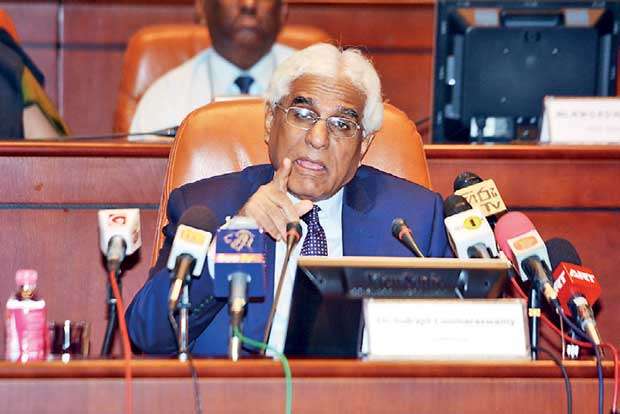12 May 2018 - {{hitsCtrl.values.hits}}

The Monetary Board of the Central Bank of Sri Lanka yesterday kept policy interest rates steady despite a sharp increase in credit to the private sector, which the Central Bank Governor identified as “seasonal.”
Accordingly, the Monetary Board decided to maintain the Standing Deposit Facility Rate (SDFR) at 7.25 percent and Standing Lending Facility Rate (SLFR) at 8.50 percent. The Statutory Reserve Ratio (SRR) is also kept unchanged at 7.50 percent.
Private credit for the month of March surged to Rs.122 billion, the highest so far this year. Central Bank Governor Dr. Indrajit Coomaraswamy during a press conference yesterday said the uptick in credit appears to be “seasonal.”
Sri Lanka’s headline inflation remained subdued at low single digit levels as volatile food prices declined due to favourable domestic supply conditions.
Core inflation too remained low indicating contained demand pressures, while inflation expectations continued to decline.
However, the Central Bank expects a temporary uptick inflation which is expected in the short term due to the impact of upward price revision to fuel, LP gas and milk powder.
“Nevertheless, with the dissipation of these transitory supply-driven price pressures and further improvements in domestic food supplies, inflation is expected to stabilise in the desired mid-single digits in the second half of 2018. Inflation is projected to remain within the 4-6 per cent target range over the medium term,” the Central Bank said.
Meanwhile the Central Bank expects a moderate recovery in economic growth. Governor Coomaraswamy foresees economy growing at 3.75 percent in the first quarter of 2018.
Sri Lanka recorded an economic growth of 3.1 percent for 2017, lowest in 16 years, largely due to bad weather that affected the agriculture sector.
“While the continuation of fiscal consolidation efforts may somewhat dampen growth prospects, the macroeconomic benefits that the economy is to derive from fiscal discipline will ensure sustained growth over the medium term.
Alongside the implementation of envisaged structural reforms and the receipt of expected inflows of foreign investment, a conducive low inflation environment and a competitive exchange rate are expected to enable the economy to attain its potential over the medium term,” the Central Bank said.
Meanwhile, the monetary authority noted that responding to the policy rate adjustment this April, overnight interest rates have declined to stabilise around the midpoint of the narrower policy rate corridor. The Central Bank cut ceiling policy rate by 25 basis points in April.
“The growth of credit extended to the private sector by commercial banks hovered around the envisaged levels although a high seasonal credit demand was witnessed in March 2018.
Based on the data up to end March 2018, private sector credit appears to have been fairly distributed across all major sectors of the economy.
As a result of the festive season-led credit expansion, broad money growth increased marginally in March 2018. However, broad money growth is expected to stabilise at around 15 per cent by end 2018,” the Central Bank noted.
Sri Lanka has continued its upward momentum in exports although the trade balance widened sharply in February due to much higher imports, driven by gold and vehicle imports.
The government recently slapped a 15 percent tax on gold imports to curb overseas purchases by traders looking to take advantage of a favourable price arbitrage with India.
The Central Bank also said the foreign reserves are at historical highs of US $ 9.9 billion by end of April 2018. However so far the exchange rate has depreciated against the US dollar by 3.1 percent.
18 Nov 2024 4 hours ago
18 Nov 2024 5 hours ago
18 Nov 2024 5 hours ago
18 Nov 2024 5 hours ago
18 Nov 2024 5 hours ago